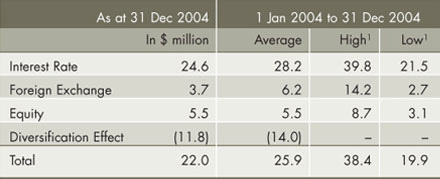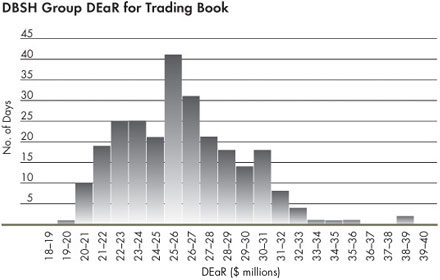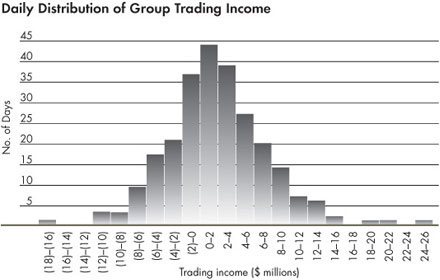| |
Approach to Risk Management
DBS embraces risk management as a core discipline to uphold
the integrity of
our business practices and ensure the safety and
soundness of our operating environment. We consider having
world-class skills in monitoring, interpreting and forecasting our
risk profile a critical internal capability. Our approach to risk
management has several components: comprehensive risk
management processes, early identification systems, accurate
risk measures, investments in people and technology to interpret
and manage risk on a daily basis, stress tests and
comprehensive process reviews in conjunction with internal
auditors, external auditors and regulatory officials.
DBS embraces risk management as a core discipline
to uphold the integrity of our business practices and ensure
the safety and soundness of our operating environment.
Risk Governance
Although business units have primary responsibility for
managing specific risk exposures, Group Risk Management is
the central resource for quantifying and managing the portfolio
of risks taken by the Group as a whole. Group Risk
Management performs the following roles:
| • |
Develops, implements, maintains, improves and communicates a consistent risk management framework |
| • |
Recommends risk limits and concentration limits |
| • |
Develops and implements an infrastructure that will qualify
DBS for risk-based regulatory capital requirements |
| • |
Provides senior management and Board with independent and
timely assessment of the aggregate risk profile concerning
significant risk concentrations, portfolio composition and quality |
| • |
Develops framework for economic capital |
| • |
Identifies opportunities to optimise risk-based return on capital |
DBS Group has implemented policies and procedures to
identify, measure, analyse and control risk across the firm.
These policies and procedures rely on constant communication,
judgment, knowledge of products and markets, and controls by
business and support units.
To assist the Board of Directors in fulfilling its duties, the Board
Risk Management Committee oversees matters relating to the
management of risk. Management is accountable to the Board
for maintaining an effective control environment that reflects
established risk appetite and business objectives. Five senior
management risk committees provide forums for discussion on
specific risk areas: the Market Risk Committee, the Credit Risk
Committee, the Group Asset and Liability Committee, the Group
Operational Risk Committee and the Commitments, Compliance
and Conflicts Committee.
Credit Risk
Credit risk is the potential earnings volatility caused by
obligors’ inability and/or unwillingness to fulfill their contractual
debt obligations. Exposure to credit risks arises primarily from
lending activities and also from sales and trading activities,
derivatives activities and from participation in payment
transactions and securities settlements. Credit exposure includes
current as well as potential credit exposure. Current credit
exposure is represented by the notional value or principal
amount of on-balance sheet financial instruments and offbalance
sheet direct credit substitutes, and by the positive
market value of derivative instruments. DBS Group also
estimates the potential credit exposure over the remaining term
of transactions. At DBS Group, a disciplined credit risk
management process integrates risk management into the
business management processes, while preserving the
independence and integrity of risk assessment.
An enterprise-wide Core Credit Risk Policy sets forth the
principles by which the Bank and its subsidiaries conduct their
credit risk management activities. It ensures credit risk
underwriting consistency across the Group, and provides
guidance to various credit management units in the formulation
of supplementary credit policies specific to their businesses.
Individual corporate credit risks are analysed and approved by
experienced credit officers who consider a number of factors in
the identification and assessment of credit risk. Each borrower is
assigned a rating under the Counterparty Risk Rating process. For
large corporate borrowers, the rating is based on the assessment
of all relevant factors including the borrower’s financial condition
and outlook, industry and economic conditions, market position,
access to capital, and management strength. The Counterparty
Risk Rating assigned to smaller business borrowers is primarily
based on the borrower’s financial position and strength, which
are assessed via the use of a validated quantitative tool. All
ratings are reviewed at least annually and more frequently when
conditions warrant. The Counterparty Risk Rating process is
further enhanced by the Facility Risk Rating System which takes
into consideration facility specific considerations such as credit
structuring, collateral, third party guarantees and transfer risks.
These credit risk-rating tools are used to assess the credit quality
of the portfolio, so that deteriorating exposures are quickly
identified and appropriate remedial action can be taken.
Consumer credit risk is managed on a portfolio basis. Business-specific
credit risk policies and procedures including
underwriting criteria, scoring models, approving authorities,
regular asset quality review and business strategy review as
well as systems, processes and techniques to monitor portfolio
performance against benchmarks are in place.
The credit control functions ensure that credit risks are being
taken and maintained in compliance with group-wide credit
policies and guidelines. These functions ensure proper
activation of approved limits, appropriate endorsement of
excesses and policy exceptions, and also monitor compliance
with guidelines established by management and regulators.
An independent Risk Review team conducts regular reviews of
credit exposures and processes. These reviews provide senior
Management with objective and timely assessments of the
effectiveness of credit risk practices and ensure group-wide
policies and guidelines are being adopted consistently across
different business units including relevant subsidiaries.
In the past few years, various “shocks” in the financial market
had adversely impacted the creditworthiness of borrowers. As a
result, stress testing of credit risk has assumed increasing
importance in the discipline of credit risk management. DBS uses
a combination of “top-down” and “bottom-up” credit risk stress
testing approaches to assess the vulnerability of the portfolio to
“exceptional but plausible” adverse credit risk events.
DBS has developed an Economic Capital-at-Risk Framework for
the measurement and management of credit concentration risk
to individual borrowers, borrower groups and industry sectors.
The Economic Capital-at-Risk Framework also provides the basis
for economic capital attribution.
Information on credit exposures by geographical area, business
line and industrial classification, and the breakdown of
investment and dealing securities are disclosed in Notes 23,
24, 25, 27 and 40.1 to the Financial Statements and the
Management Discussion and Analysis chapter.
Country Risk
The management of cross-border risk is embedded in a Country
Risk Management Framework, which was approved at the Board
level. The Framework includes an internal country risk rating
system which taps into the expertise of the Bank within the
markets it operates, and where the country assessments are made
independent of business decisions. Benchmark country limits are
set to delineate when exposures approach levels that may imply
concentration risk. Day-to-day operational country limits, called
working limits, are also imposed to manage the shape and
growth of the cross-border exposures as they build up. A rigorous
environment scanning process is in place, with proactive action
as warranted to expand or roll back country exposures.
Trading Market Risk
Trading market risk arises from changes in market rates such as
interest rates, foreign exchange rates, equity prices and credit
spreads, as well as in their correlation and implied volatilities.
DBS Group takes trading market risk in the course of market
making, structuring and packaging products for investors and
issuers, as well as to benefit from market opportunities.
The trading market risk framework comprises the following
elements:
| • |
Limits to ensure that risk-takers do not exceed aggregate risk
and concentration parameters set by senior management and
the Board |
| • |
Independent validation of valuation and risk models and
methodologies |
| • |
Independent mark-to-market valuation, reconciliation of
positions and tracking of stop-loss for trading positions on a
timely basis |
| • |
New product/service process whereby risk issues are
identified before new products and services are launched |
DBS adopts a Daily-Earnings-at-Risk (DEaR) methodology to
estimate the Group’s trading market risk with a 99% level of
confidence. DEaR is computed using a combination of parametric
(variance-covariance) and historical simulation approaches. It
takes into account all pertinent risk factors and covers all financial
instruments which expose the Group to market risk across all
geographies. On a daily basis, DBS computes DEaR for each
trading business unit and for each risk type such as foreign
exchange, interest rate or equity which are then rolled up to the
Group level. The DEaR figures are backtested against profit and
loss of the trading book to validate its robustness.
Daily Earnings at Risk
The table below provides the year-end, average, high and low
DEaR for the trading risk exposure of DBS Group during the year:

1) The high (& low) DEaR figures reported for each risk class did not necessarily occur on the same
day as the high (& low) reported for total. A corresponding diversification effect cannot be
calculated and is therefore omitted from the table.
The charts below provide the range of DEaR and the daily
distribution of trading income in the trading portfolio for the
year ended December 31 2004:


Although DEaR provides valuable insights, no single measure
can capture all aspects of trading market risk. To complement
the DEaR framework, daily stress testing is carried out to
monitor the Group’s vulnerability to unlikely but plausible shocks
to individual market factors. Stress limits are also established
accordingly. On a monthly basis, a set of scenarios (historical
or hypothetical) are developed and applied on the trading
books to further assess the potential impact from simultaneous
shocks on all market rates, prices and their implied volatilities.
The Group’s Market Risk Committee meets fortnightly to review
and give direction on the level of market risk taken within DBS
Group; its breakdown by desk and geography risk type;
trading profit and loss; stress testing results; risk model
backtesting performance; and requests for limit changes. The
Greater China Market Risk Committee focuses on the same
market risk metrics and issues within the Greater China area.
Information on the Group’s financial assets and liabilities in
relation to exposures to interest rate and foreign exchange risks
can be found in Notes 37.2.2 and 37.2.3 to the Financial
Statements.
Structural Market Risk
The Group Asset and Liability Committee (“Group ALCO” or
“GALCO”) oversees the structural interest rate risk, structural
foreign exchange risk and funding liquidity risk in the Group.
It allocates core limits to regional/local ALCOs in the different
countries and ensures that the consolidated exposures of the
Group are within prudent levels. Regional/local ALCOs are
responsible to manage the risks in their areas including the
setting of operational limits and guidelines to fine tune risk
management, consistent with the Group’s Asset and Liability
Management (“ALM”) Policy.
Structural interest rate risk arises from mismatches in the interest
rate profile of customer loans and deposits. This interest rate
risk has several aspects: basis risk arising from different interest
rate benchmarks, interest rate repricing risk, yield curve
movements and embedded optionality.
In managing structural interest rate risk, the Bank tries to
achieve a desired profile given the strategic considerations and
market conditions of the various business segments. To monitor
the structural interest rate risk, various tools are used including
repricing gap reports, sensitivity analysis and income
simulations under various scenarios. These measures take into
account both economic value and earnings perspectives.
In structural foreign exchange exposures, the Group’s policy is
to manage the effect of exchange rate movements on its
earnings and capital accounts. Foreign currency loans and investments in fundable currencies are generally funded with the
same foreign currencies. Non-fundable or illiquid currencies
may be hedged with instruments such as non-deliverable
forwards. For currencies with high hedging costs or lack of
liquidity, alternative strategies may be used.
An Investment Framework governs the Group’s investment of
funds arising from the banking business. These investments are
separately subject to Board and senior management limits on the
portfolio size, credit quality, product and sector concentrations
and market risk sensitivities under the Framework. Investment
market risk is monitored by risk type using sensitivities and by
valuation action triggers. Valuation as well as validation of
models used in valuation and risk management are carried out
by independent support units.
Liquidity Risk
Liquidity risk is the potential earnings volatility arising from being
unable to fund portfolio assets at reasonable rates over required
maturities. Liquidity obligations arise from withdrawals of deposits,
repayments of purchased funds at maturity, extensions of credit
and working capital needs. DBS seeks to manage its liquidity risk
across all classes of assets and liabilities to ensure that even under
adverse conditions, DBS has access to funds at a reasonable cost.
The primary tool for monitoring liquidity is the maturity
mismatch analysis, which is monitored over successive time
bands and across functional currencies. This analysis includes
behavioural assumptions on, inter-alia, customer loans, customer
deposits and reserve assets. This is tested under normal and
adverse market scenario conditions. Limits are established by
the Board and senior management for the maximum cumulative
cash outflows over successive time bands. Various liquidity
ratios, concentration and stress limits are additional tools
employed by the Bank to manage funding liquidity risk.
We consider having world-class skills in monitoring,
interpreting and forecasting our risk profile a critical
internal capability.
As part of its liquidity risk management, DBS Group focuses on
a number of components, including tapping available sources
of liquidity, preserving necessary funding capacity and
contingency planning.
Information on the Group’s financial assets and liabilities in
relation to exposures to interest rate risk, currency risk and
liquidity risks can be found in Notes 37.2.2, 37.2.3 and
37.2.6 to the Financial Statements.
Operational Risk
Operational risk is the risk of loss resulting from inadequate or
failed internal processes, people or systems, or from external
events. An Operational Risk Management Framework has been
developed to ensure that operational risks within the DBS Group
are properly identified, monitored, managed and reported in a
structured, systematic and consistent manner. Key elements of the
Framework include control self-assessment, risk event
management and key risk indicator monitoring. To reinforce
accountability and ownership of risk and control by the business
units and support units, Unit Operational Risk Managers are
appointed to assist the unit heads in driving the overall risk and
control agenda and programmes at the units.
The day-to-day management of operational risk exposures is
through the maintenance of a comprehensive system of internal
controls, supported by an infrastructure of robust systems and
procedures to monitor transaction positions and documentation.
A set of Core Operational Risk Standards have been established
to provide guidance to business units and support units on the
baseline internal controls to be put in place to ensure the safety
and soundness of their operating environment. Other major
operational risk mitigation programmes include Business
Continuity Management and the Global Insurance Programme
that apply to all DBS entities and units in all locations.
Each new product or service introduced is subject to a rigorous
risk review and signoff process where all relevant risks are
identified and assessed by departments independent of the
risk-taking unit proposing the product. Variations of existing
products, as well as outsourcing and process centralisation
initiatives, are also subject to a similar process. |